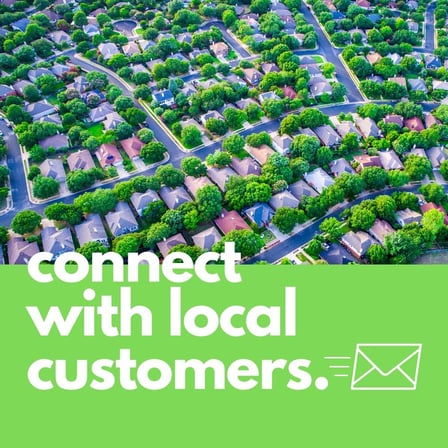Budget-Friendly Direct Mail Options
In today's digital-heavy world, finding ways to make your business stand out is crucial. Adding in print marketing advertising is a great way to break up the redundancy. A concern you might have is the cost of print pieces, but that doesn't have to be a concern anymore. Print materials fit into a wide range of budgets, offering a cost-effective way to enhance your campaign and reach your target audience.
Let’s take a look at different ways you can add print materials into your campaigns, in a way that fits your budget.
If your budget is smaller ... low-cost direct mail tactics
If you have a smaller budget for your print campaign, don’t worry! There are still plenty of ways for you to add print. Low-cost direct mail tactics can be effective for reaching a targeted audience without breaking the bank. Here are a few cost-effective strategies for implementing direct mail campaigns:
Postcards and flyers:
Postcards are versatile print materials that are commonly used for mailing purposes. They are single-sheet cards that typically feature an eye-catching image or design on one side, while the other side provides space for a personalized message and the recipient's address.

Another option is flyers; single-page leaflets or promotional materials designed for mass distribution. They are commonly used for advertising products, services, events, or any other information that an individual or business wants to convey to a wide audience. Flyers are typically printed on one side or both sides of a sheet of paper.
Here are some key reasons why postcards and flyers are considered cost-effective:
Printing costs:
Postcards and flyers are typically small and have a simple design, which reduces printing costs. Printing in bulk often comes with discounts, making it more economical to produce a large quantity of postcards and flyers.
If you're looking to print a lot at one time, Aradius Group can help! Our Canon Prostream 3133 Printer can do 62 million pages per month or 114,000 per hour.
Simplicity in design:
Postcards and flyers typically have a concise design with limited space for content. This simplicity makes them easy and quick to design, reducing design costs. Many businesses and individuals create postcards and flyers using templates or in-house design resources.
Postage costs:
Postcards usually qualify for lower postage rates compared to larger mail pieces. They are often cheaper to mail because of their standardized size and weight, as defined by postal regulation.
Flyers can be distributed in various cost-effective ways, too, such as hand-to-hand distribution, leaving them in public places, or including them in direct mail campaigns. The distribution cost per flyer is relatively low, especially when compared to more elaborate marketing channels.
If you have a little more room in your budget ... Every Door Direct Mail
If you want to implement an entire cost-effective print campaign but have a bit more in your budget, then Every Door Direct Mail is for you. It’s a service offered by the U.S. Postal Service (USPS) that makes it easy to reach every business or residential customer in a given neighborhood, city, or zip code. It’s the simplest, most cost-effective way to acquire new business and promote your brand to every door in a targeted area. So, how does it work?
Select target area:
Your business will choose the specific neighborhoods or ZIP codes you want to target. This is often based on demographics, proximity to the business, or other criteria.

Choose mail piece size:
EDDM offers flexibility in the size and format of the mail piece. You can choose from various sizes, including postcards, flyers, or brochures. The selected size determines the postage rate.
Design and print mail pieces:
Businesses design their mail pieces according to USPS guidelines. The mail pieces must include the EDDM indicia, a specific format for the recipient's address, and meet size requirements. Many businesses use professional designers or online design tools for this purpose.
EDDM Benefits
Cost-effective:
There are a few things that can impact the cost of a direct mail piece like material weight, bulk discounts and even printing choices. With EDDM, you’ll see that most companies will spend around $0.19 per piece on a direct mail campaign. That’s compared to the average price of a regular direct mail campaign which can cost anywhere between $.30 and $10 per piece.
No postal limits:
USPS’s EDDM program is one of the few ways you can send out 200-5,000 pieces of mail per day without having to have a postal permit. If you didn’t have EDDM then you’d be required to purchase a mailing permit. But EDDM allows you to bypass that step and get your pieces of mail out quicker and to more people.

If you're interested in EDDM and need help creating pieces that meet EDDM requirements, then Aradius Group has you covered! Reach out and we’ll get you in contact with one of our experts.
If you have a larger budget ... Personalization
Let’s say you have a little more room in your budget and want to explore some mid-range ways to add print into your next campaign. The best way to step up a simple print campaign is with personalization. That’s where targeted mailing lists come in.
Targeted mailing lists
What’s a mailing list you might ask? A mailing list is a collection of names and addresses (including physical addresses and email addresses) used by an individual or an organization to send material to multiple recipients using a direct mail campaign. A mailing list is generally compiled from people who have shown interest in your business or products and filled out a form or from a purchased list.
Mailing lists are broken up into categories usually, so let’s take a look at a few mailing lists you might consider for your business:
Demographic-based lists
Lists are segmented based on demographic criteria such as age, gender, income, education level, or other characteristics. These lists help marketers tailor their messages to specific groups.
Business mailing lists
Business mailing lists contain contacts within companies and organizations. These lists may be segmented by industry, company size, job title, or other relevant business criteria. They are often used for B2B (business-to-business) marketing.
Geographic lists
Lists are organized by location, such as city, state, or country. These can be useful for local businesses or organizations targeting specific regions.
Newsletter subscribers
These lists consist of people who have subscribed to newsletters, whether they are from companies, websites, or other organizations. Newsletter subscribers are generally interested in receiving regular updates and content.
Knowing the important details about your potential customers allows you to add personalized touches to your print campaigns. This could include adding a name, spotlighting a hobby they enjoy, or even sharing a fact. These touches all add up to increased open rates, more engagement, and an increase in revenue. People are more inclined to interact and spend money with companies that make them feel seen.
If you’re interested in setting up a mailing list – we’ve created a Mailing List Process guide. It breaks down everything you need to know before getting started, list formats, and how to organize your list.
The takeaway
If you’re looking for a way to step up your next campaign, consider adding print pieces! Leveraging budget-friendly direct mail pieces is a strategic choice for businesses aiming to reach their target audience effectively while keeping costs in check. By harnessing the power of direct mail, organizations can deliver personalized and tangible messages directly to potential customers, fostering meaningful connections and driving engagement.
When you’re ready to take the leap into direct mail, reach out! We can discuss our EDDM solution, mailing lists, and direct mail with you.

